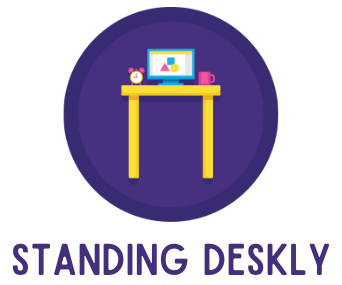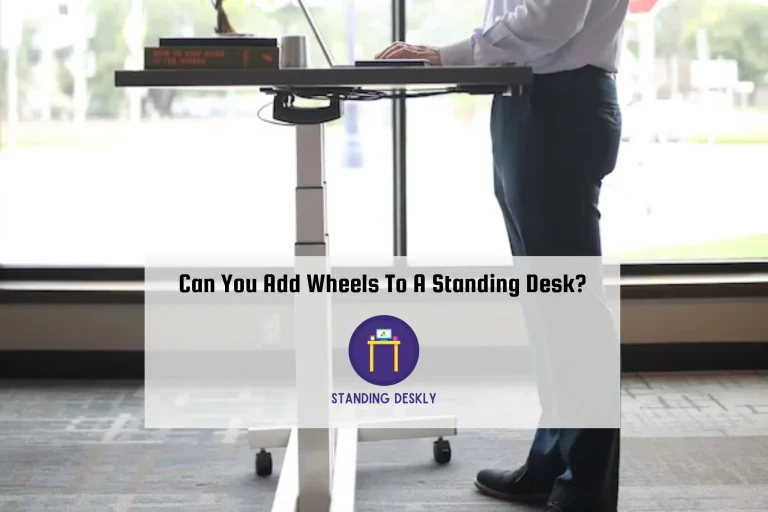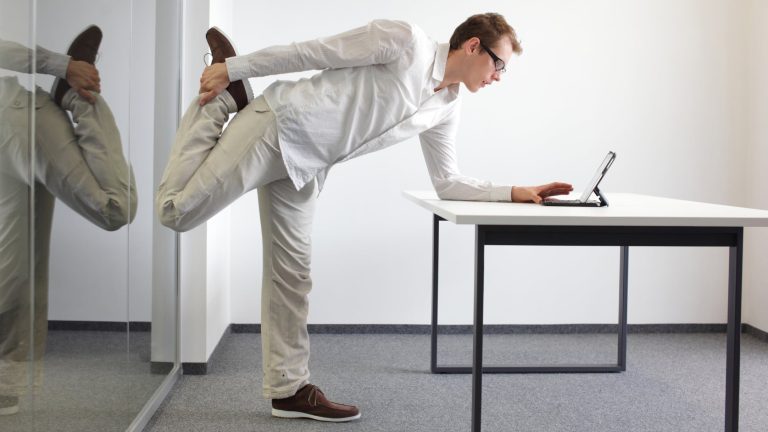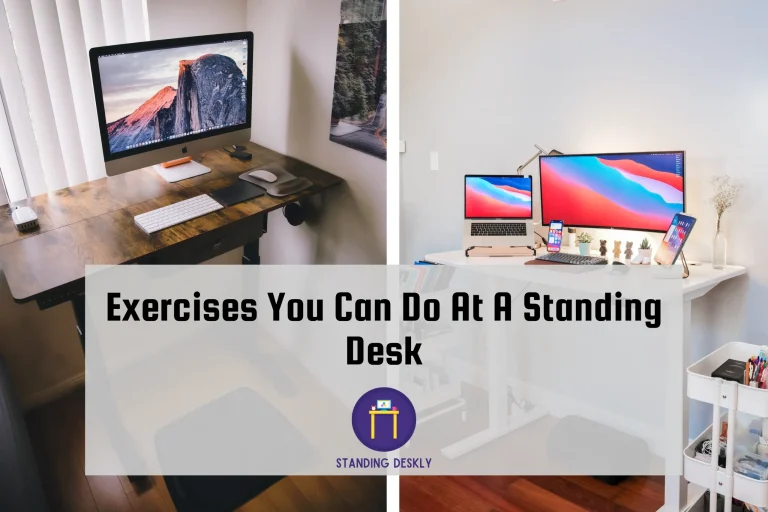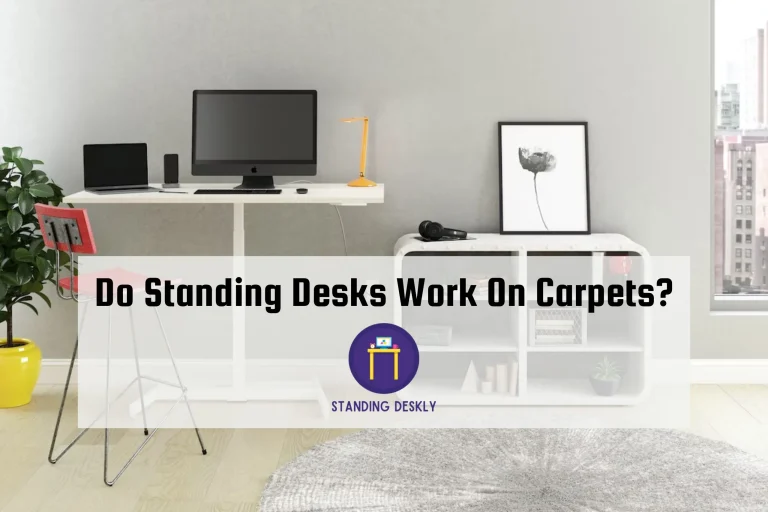Do Standing Desks Help With Neck Pain?
The answer is yes, but they are not the only solution. Sitting for long periods can cause poor posture, cramped muscles, and a decline in your overall health. On the other hand, standing for extended periods can also lead to discomfort in your feet, calves, legs, and back. So, what’s the best approach? A combination of standing, sitting, and engaging in regular physical activity is the key to preventing neck pain and maintaining good health.
By incorporating a standing desk into your work routine, you can improve your posture and minimize the stress on your neck muscles. Make sure to choose a desk with adjustable height settings, as this will allow you to transition between sitting and standing throughout the day.
When setting up your workstation, ensure that your monitor is at eye level and your keyboard and mouse are at chest height. Additionally, consider adding an anti-fatigue mat for added comfort and support. And, most importantly, remember to take breaks to move and stretch periodically. This way, you’ll not only combat neck pain but also improve overall wellbeing.
Benefits of Standing Desks for Neck Pain:
1. Improved Posture: Standing desks promote better posture than traditional sitting desks. When you stand, it’s easier to keep your head, neck, and shoulders aligned, reducing the strain on your muscles and preventing neck pain.
2. Reduced Pressure on the Spine: Sitting for long periods puts added pressure on the spine, leading to compressed discs and eventual neck pain. Standing desks help alleviate this pressure and improve spinal health.
3. Increased Muscle Activation: Standing forces you to engage your core muscles, which support your spine and neck. This muscle activation reduces the workload on your neck, minimizing pain.
4. Encourages Movement: When using a standing desk, it’s easier to take small breaks and move around. These movements keep your muscles from becoming stiff and help to eliminate neck pain.
5. Customizable Ergonomics: Many standing desks offer adjustable height features, allowing you to position your work surface at the perfect height for your body. This customization ensures that your computer monitor is at the right level for your gaze, reducing neck strain and subsequent pain.
How standing affects the neck
Standing up straight can work wonders for your neck health, especially if you’re someone who spends hours sitting at a desk. When you sit for extended periods, your neck, shoulders, and back can become rigid and tense, resulting in pain and discomfort. By opting for a standing desk or incorporating regular standing breaks throughout the day, you give those muscles a chance to stretch and relax.
However, it’s important to remember that simply standing all day isn’t a magical cure. The key to minimizing neck pain is not only standing but also maintaining proper posture and engaging in regular movement. Make sure your standing desk is at the right height, with your computer monitor directly in front of you and the top of the screen at eye level. This will help to reduce the strain on your neck muscles.
Additionally, make sure you take breaks to walk around, stretch, and change positions every 20 minutes or so. This will encourage better blood flow, reduce muscle fatigue, and ultimately alleviate the tension that can contribute to neck pain. By making these small adjustments and incorporating more movement in your day, your neck will surely thank you!
Tips for Using a Standing Desk Correctly to Relieve Neck Pain
1. Maintain good posture: Stand upright with your feet hip-width apart, and slightly bend your knees. Keep your back and shoulders straight, and engage your core muscles to support your spine.
2. Adjust the desk height: Set the height of your standing desk so that your elbows are at a 90-degree angle while typing, and your computer screen is at eye level. This will help prevent neck and shoulder strain.
3. Take breaks: Avoid standing for long periods without taking short breaks. Walk around or do some gentle stretches to relax your muscles and improve circulation.
4. Use an anti-fatigue mat: Standing on a cushioned mat can reduce the pressure on your feet and knees, and help prevent discomfort in your neck and back.
5. Invest in an ergonomic chair: If possible, use an adjustable-height desk that allows you to alternate between sitting and standing throughout the day. Sitting for short periods can help prevent muscle fatigue, reducing your risk of neck pain.
6. Maintain a neutral wrist position: While typing, keep your wrists straight and your fingers relaxed. This will help prevent strain that can lead to neck and shoulder pain.
7. Be mindful of screen time: Limit the time you spend looking down at your smartphone or tablet, as this can exacerbate neck pain. Raise the device to eye level or take breaks from screen time whenever possible.
Combining Standing and Sitting: The Ideal Solution to Alleviate Back and Neck Pain
You may be wondering if standing desks are the ultimate solution for alleviating back and neck pain, and the answer is both yes and no. Switching to a standing desk can’t completely get rid of all your pain, although it can help reduce negative effects caused by sitting for long periods. The key is to combine periods of standing and sitting to promote better overall health and keep the body in motion.
When purchasing a standing desk, ensure it offers flexible height adjustments so that you can easily switch between standing and sitting throughout the day. In addition to this, incorporating regular exercise and movement breaks into your routine is essential for preventing pain caused by sedentary lifestyles.
Set an hourly alarm to remind yourself to move around, and keep a set of reliable stretches or movements available to provide relief when necessary.
Ultimately, combining standing and sitting, coupled with regular exercise, can offer an effective way to reduce your back and neck pain. Don’t forget to keep moving and prioritize exercise in addition to using a standing desk in order to promote better posture and overall health.
Adjustable Standing Desks: How They Relieve Neck and Back Pain
Do you often experience neck and back pain while working at your desk? You’re not alone! Many people suffer from these issues due to poor ergonomic design in their workplace. But did you know that adjustable standing desks can provide significant relief and help improve your posture?
One of the main contributors to neck and back pain at work is sitting for long periods in a slumped position, which puts a lot of stress on your neck and upper back muscles. A height-adjustable standing desk can alleviate this pressure and promote a healthier posture. By standing for just over an hour a day, you can greatly reduce your risk of developing these kinds of pains.
However, it’s important to remember that standing all day isn’t the perfect solution either, as it can also lead to issues with your feet, calves, and legs. The key is to find the right balance between sitting and standing to keep your body in motion and encourage better ergonomics.
To properly set up your adjustable standing desk, ensure your elbows are at a comfortable height, position your monitor directly in front of you, and use an anti-fatigue mat for extra support. With these steps, you’re well on your way to relieving neck and back pain while creating a more comfortable and productive work environment.
Conclusion: Say Goodbye to Neck Pain with a Healthy and Productive Work Lifestyle
In conclusion, it’s time to say goodbye to neck pain and embrace a healthy, productive work lifestyle with the help of standing desks. By incorporating ergonomics and movement into your daily routine, you can significantly reduce the risk of developing neck pain and other discomforts associated with long hours of sitting. As we have seen, standing desks have been proven to help alleviate neck pain and contribute to overall well-being.
So, make the change and invest in a standing desk to not only improve your posture but also boost your mood, motivation, and productivity. Remember, it’s not just about standing all day, but striking a balance between sitting and standing. A height-adjustable standing desk can offer you the flexibility and ease to switch positions whenever needed.
Take charge of your health and adopt a proactive approach to prevent neck pain by creating a comfortable and ergonomic work environment. By doing so, you’re not only helping yourself but also contributing to a happier and healthier workforce. Give yourself the gift of comfort and improved health by incorporating a standing desk into your work life.

I’m the author and developer of Standingdeskly, the go-to site for standing desk enthusiasts. I provide comprehensive reviews of standing desks along with office setup tips. Combining years of research and personal experience, our goal is to make it easy for you to find the perfect standing desk tailored to your needs.
